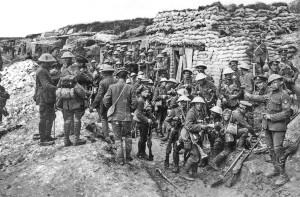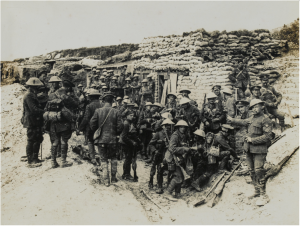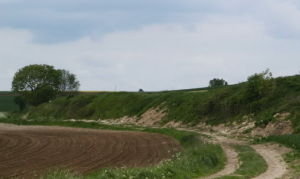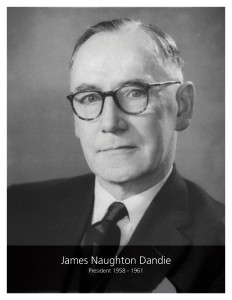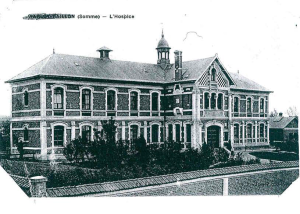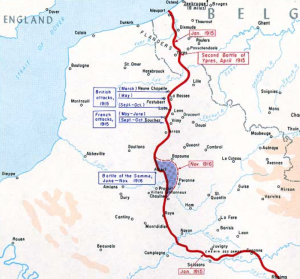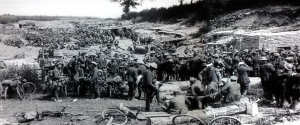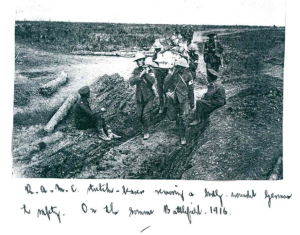Monthly Archives: July 2016
29th July 1916 Saturday
All material produced or reproduced here and throughout this work is the sole copyright of the author and the family of Doctor D.C.M. Page MC.
“Next day we were on the move again – a 2½ hours’ march to Sarton – another respectable village, where I got a good billet. On again in terrific heat from a scorching sun to Doullens. This was a cruel march for the men in full war kit – steel helmets, etc, and many fell out en route, suffering from sun-stroke, fatigue and sore feet. I had a most hectic time getting lifts for them in passing ambulances, lorries and French carts.”
Find out about our connection with Dr Page and an introduction to his diary here
28th July 1916 Friday
All material produced or reproduced here and throughout this work is the sole copyright of the author and the family of Doctor D.C.M. Page MC.
“We remained in the line until Friday, July 28th, and during our four days’ turn of duty I visited all the companies up in the front line. On one occasion I had a hot time being caught in a nasty shrapnel barrage at one point, and then landing amongst some heavy stuff at another. It was “windy” work, but I got safely back to White City. Parts of the front line trench were non-existent as a result of the enemy trench-mortar bombardment, and one had to crawl across these gaps to escape observation from the German snipers. It was exciting.
A Somerset Battalion relieved us on the 28th, and we proceeded via Courvelles to Bus, a nice, wee village, where the battalion was accommodated in huts. All the officers slept in one big hut, and as I had my camp bed with me, I was all right. I rode on to Sailly as soon as possible, and had a bath.”
Find out about our connection with Dr Page and an introduction to his diary here
25th July 1916 Tuesday
All material produced or reproduced here and throughout this work is the sole copyright of the author and the family of Doctor D.C.M. Page MC.
“Next day (July 25th) I moved my Aid Post down to an old gun-pit near White City. It was quite a good spot, and had an excellent dug-out, fully 20ft deep for using during shelling on the enemy’s part.”
Find out about our connection with Dr Page and an introduction to his diary here
24th July 1916 Monday
All material produced or reproduced here and throughout this work is the sole copyright of the author and the family of Doctor D.C.M. Page MC.
“We packed up about noon on the 24th – and moved into the trenches in front of Auchonvillers. It was a long trail – about 7 miles – and I was at the rear of the column, as usual. Just as we were approaching Battalion Headquarters at White City and going down the communication trench, named Fifth Avenue, the Huns spotted us, and started shelling with whizz-bangs. We got merry Hell for 20 minutes, and I thought my last minute had come. We lay like pancakes at the foot of the trench till it was all over. Four men were killed and three wounded. They belonged to the 9th Fusiliers whom we were relieving. The trenches were blown in. I attended to them and sent the wounded men back in charge of stretcher-bearers. Then I went on to my Aid Post which was fully 400 yards from Headquarters at *White City, at the junction of Mount Joy Avenue and Roman Road. It was a hopeless place, and I found that I couldn’t get a stretcher into the dug-out. Then the Huns started to drop shells all round the place – great big “crumps”. They smashed up our engineers’ dump close by – picks, shovels, wheel-barrows etc, were flying all over the place, and the trench was knocked in. With my stretcher-bearers I took refuge in a 20ft deep dug-out near at hand. Whilst disappearing into this refuge I was violently struck by a piece of something hard – wheel-barrow, shovel, shell, I know not – on the back. This helped to accelerate my descent into the lower regions, and luckily only badly bruised me and gave me a fright.
It felt safe down there, but I didn’t like the way the whole place shook and the candles went out when a big shell dropped over-head. The place was full of rats too, which didn’t add to one’s comfort. Twice during our first night in the line the Huns shelled that dump, and I had the “wind-up” properly. We had one man killed, one wounded, and one shell-shocked during the night. About 11pm the Huns did a lot of damage in our front line with trench-mortars. Our field guns gave them HELL for 4 minutes, which soon stopped their nonsense.”
*White City was a dressing station that was so called because it was dug into a chalk ridge, near Beaumont Hamel.
Find out about our connection with Dr Page and an introduction to his diary here
18th July 1916 Tuesday
All material produced or reproduced here and throughout this work is the sole copyright of the author and the family of Doctor D.C.M. Page MC.
“On the 18th July, we marched into Happy Valley – a dismal hole, full of troops. I managed to “acquire” a moth-eaten bell-tent and made myself as comfortable as possible. Here I met my old school pal, *Jimmy Dandie, whose battery of heavy guns was situated about a mile from us at Colincamps. We had a great yarning together, and he had tea and dinner with us – the latter meal we partook of in the Field Ambulance Dressing Station Mess on the hill-side. Here the Battalion rested until July 24th. I had huge sick parades each day – 60-80 strong – but there were no cases of serious illness.”
*Douglas had attended George Watson’s College in Edinburgh with James Dandie. James Naughton Dandie saw the whole of the war on the front, having served since 1914 with the Royal Garrison Artillery.
Born in 1894, he was the same age as Douglas and had a distinguished career both in the war where he became Acting Captain and like Douglas won the Military Cross. By the time of the second world war he was practising as a solicitor in the Stirling area, later becoming President of the Law Society of Scotland and lived until 1976.
Find out about our connection with Dr Page and an introduction to his diary here
13th-15th July 1916 Thursday to Saturday
All material produced or reproduced here and throughout this work is the sole copyright of the author and the family of Doctor D.C.M. Page MC.
“We left Morlancourt on July 13th. Before we left the Bantam Division came into the village. I saw some of the Edinburgh “Bantams” but hadn’t time to look for Gordon Sturrock. We marched via Ville, Buire, Lavieville and Henencourt to Warloy. We had a triumphal procession. Some of our men carried captured German helmets, caps & c and in the villages we passed through the battalions turned out and gave us a great reception. A great body of cavalry passed us going towards the front. We cheered them on, and they gave us a cheer. When we got to Warloy about 10.30pm we found that the Brigade had gone on in motor buses to an unknown destination! We were left behind, forgotten and uncared for!
However, we got hold of the Town Mayor, who found us billets, and food. I had a heavy doze of cold, and felt pretty miserable. Heard that the 3rd, 7th and 21st Divisions attack the German 2nd line at dawn tomorrow. We rested all next day (July 14th) in Warloy and I spent most of the day in bed trying to get rid of my cold.
On 15th July we got word from Headquarters to proceed to Thievres and I was conveyed there in an old field ambulance feeling pretty miserable with a sore throat and bunged up head. No sooner had I rejoined the 130th Field Ambulance than I was pushed off to Authie to do duty as Medical Officer with the 13th Royal Welsh Fusiliers. Their Doctor, Capt. Lawrence – was killed in Mametz Wood. The Commanding Officer – Col. Campbell – was a Scot, and a right good sort. I got a good billet.
The Battalion only remained in Authie village for two days. On one day we were inspected by Major General Hunter-Weston the Corps Commander, and on the other I got 200 men of the Battalion bathed at the baths at Covin. I had a grand, hot bath myself!
I was also busy with big sick-parades – most of the men were badly nerve-shocked after the ordeal of Mametz Wood – reorganising the stretcher-bearers and procuring fresh medical stores.”
After the 13th July Douglas describes the men on the move, sick, injured and practically exhausted after the trauma of Mametz Wood. In fact they had suffered so much that the whole 38th Welsh division was withdrawn from frontline combat for a year and didn’t fight again until 1917. They made their way slowly back behind the lines to Poperinghe, west of Ypres which was considered to be safe in British hands, at least for the time being.
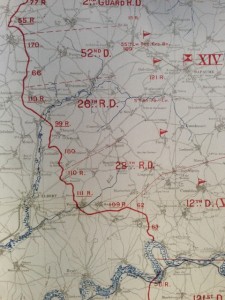
Map of German positions on the Somme. Reproduced with the permission of the National Library of Scotland. https://maps.nls.uk/index.html
Find out about our connection with Dr Page and an introduction to his diary here
11th-12th July 1916 Tuesday & Wednesday
All material produced or reproduced here and throughout this work is the sole copyright of the author and the family of Doctor D.C.M. Page MC.
“All that night and all next day (11th July) and night right up till 9 0’clock on Wednesday, July 12th we were busy getting all our wounded and evacuating them.
On both nights 100 cavalry men came up to clear the wounded from Caterpillar Trench, but they weren’t of much use to us as they were all, officers included, all terribly ‘windy’ and scattered whenever a shell dropped anywhere near them. They had never been under fire before.
I saw the 14th Welsh come out of the wood – 180 strong – and only two officers to lead them. The 13th Welsh came back about 200 strong. It was a terrible sight. The cold was intense, both nights we got no sleep. I felt pretty rotten by 9 o’clock on 12th July when we were relieved as I’d had no sleep for three days and nights and had been on my feet practically all that time, attending to wounded. Food hadn’t been plentiful either, except tea and biscuits, but a bottle of brandy and a slab of chocolate spun out over three days, helped to keep spirits up.
On our relief we trudged wearily up to Minden Post. Then the Huns shelled us heavily and wounded a few men slightly. We were all so tired that we could hardly throw ourselves into shell-holes to get cover. In fact, I think we were so dazed that we didn’t bother what happened to us. We stood on the crest of the hill for a moment to watch the Huns shelling Contalmaison. We were promised motor lorries to convey us back to Morlancourt, but none appeared and we had to send them down in relays of motor ambulances. The result was that I didn’t get down till 3 o’clock in the afternoon, but I got some good hot food and felt better.
Colonel Davies and some officers left for Mericourt to entrain for Veuchelles near Langpre between Amiens and Abbeville. Our wearied stretcher-bearers with myself and other officers were left behind to rest and were very kindly treated by the 23rd Field Ambulance, officers and men. I had a shave and a good wash and bedded down in a tent at 6pm – dead beat! The 38th Division, although practically wiped out, did its job and captured Mametz Wood. The 113th *Brigade mustered up a little more than a thousand men after the battle.
They went in over 3000 strong. The Divisional General – **Major General Phillips – was sent home on 9th July- incompetence.”
*A Brigade would normally consist of 3000 to 4000 men, made up of usually four battalions. Two brigades would make up a division.
** General Ivor Phillips was mentioned in earlier posts see here and here
Find out about our connection with Dr Page and an introduction to his diary here
9th-10th July 1916 Sunday & Monday
All material produced or reproduced here and throughout this work is the sole copyright of the author and the family of Doctor D.C.M. Page MC.
“On Sunday July 9th, I marched on to the Minden Post. The 114th Brigade attacked Mametz Wood at dawn on 10th and we got orders to evacuate the wounded from the field of battle. Our artillery played Hell with the Hun alright and we did not sleep.
We were on the move at 2am on 10th July and marched through mud and dirt to a spot in the old German line called ‘The Triangle’, passing through the remains of the village of Carnoy. Our Dressing Station consisted of one filthy dug-out with a foot of water in it. Capt. Anderson and I with a few men remained here whilst Lieuts. Anderson and Buckly with the main body of the stretcher-bearers went further forward. Between three-thirty and four a.m., our guns bombarded the German position. The din in the valley – Happy Valley – it was named – was terrific and the flashes of the guns lit up the whole countryside. The noise of the shells swishing over our heads towards German territory seemed to be like a load pressing down on one’s head. Our attack on Mametz Wood was due to start at 4am. We got the first casualties in by 5 o’clock and had them coming down from the front line by the hundreds all day.
Capt. Anderson and I worked like niggers all day and had no time to take food until 3p.m., when we had a tin of tea and some bread and cheese, at the Divisional Rest Station behind us. It was most welcome and did us good. Some of our poor men were horribly wounded. The 14th Welsh got badly cut up, nearly all the officers being wounded. My friend Major Williams, was brought down to us on a stretcher, badly wounded in the abdomen. He must have been suffering agonies of pain, but was very cheery. He lived alright, but it was a miracle.
The 13th Welsh was badly hit too and my friend Major Edwardes (George Edwardes’ son) was killed. Colonel Rickets of the 10th Welsh was badly wounded in the thigh. Two Doctors were killed – Lawrence, of the 11th South Wales Borderers and Raymond Jones of the 129th Field Ambulance and David of the 131st Field Ambulance was wounded. Our Brigade captured the wood, but lost very heavily in the effort. Lots of Germans were captured and we had a few wounded Huns to deal with – they looked miserable enough and they were mostly very young.”
Find out about our connection with Dr Page and an introduction to his diary here
8th July 1916 Saturday
All material produced or reproduced here and throughout this work is the sole copyright of the author and the family of Doctor D.C.M. Page MC.
Douglas throughout the mayhem managed to get some time away from the chaos to survey the scene for himself and gives us a fascinating eye-witness account of part of the battle. It is important to note that his use of phrases like “It was a wonderful, never to be forgotten sight” is meant to convey the enormity of what was taking place rather than any glorification of scenes that he witnessed.
“Father Brown our popular R.C. Padre came up next day (8th) and he and I went over every piece of ground where fighting took place on Monday. We saw our old trenches and the German front line trench. The harm wrought was terrific. The whole countryside was scarred with shell-holes, Large and small. ‘No Man’s Land’ was full of craters and the German trenches were battered to pieces. The stench was awful and the craters were full of blood-stained water. There were still many German dead lying about- a pitiful sight. We got a splendid view of the valley before us as it was a clear sunny day, and saw the villages of *Mametz and Fricourt which were just names of smashed bricks. Our guns were shelling Mametz Wood heavily and the Germans were putting a few ‘crumps’ into Fricourt. It was a wonderful, never to be forgotten sight. Two of the Welsh Division Battalions – Cardiff City and the 10th S.W.B (South Wales Borderers)- attacked Mametz Wood during the day and got badly cut up. Two of our ambulance stretcher bearers were killed. Our men had to carry wounded four miles over shell holes and with mud up to their knees in places.”
*The village of Mametz in the Somme Valley is not to be confused with Mametz in the Pas de Calais where Douglas met Gwilym Lloyd George on 20th December 1915. Read about that meeting here.
Find out about our connection with Dr Page and an introduction to his diary here
7th July 1916 Friday
All material produced or reproduced here and throughout this work is the sole copyright of the author and the family of Doctor D.C.M. Page MC.
“Friday July 7th was a miserable day – cold and very wet. I was hounded out of bed at 5am and proceeded ‘up the line’ with Burke and 100 stretcher-bearers. We had a long tramp up and down dale. Guns were all around us big and small. After a good deal of wandering about, we arrived at our Advanced Dressing Station at ‘The Citadel’. Here I was left with five men while the others went across to the 131st Field Ambulance A.D.S. at Minden Post. Here I had sick and wounded to care for and evacuate by motor ambulance in the early hours of the morning. We were up to our knees in liquid mud and the mess room was flooded out.”
Find out about our connection with Dr Page and an introduction to his diary here
